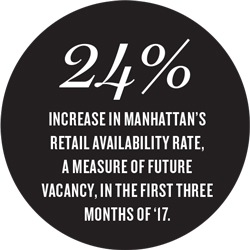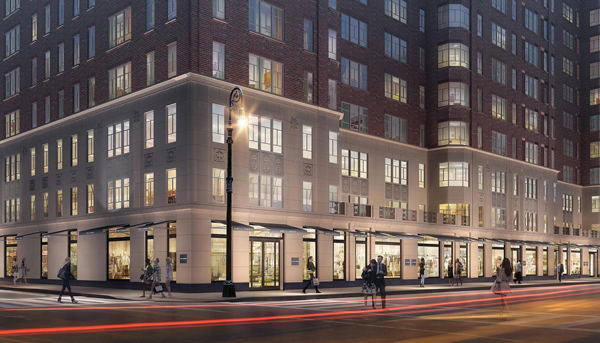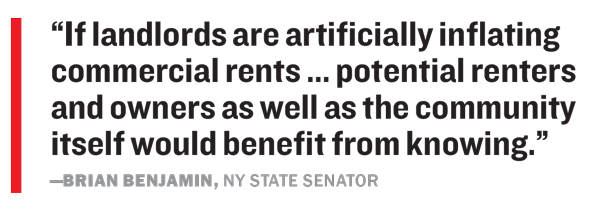UPDATED, Sep. 21 , 3:13 p.m.: In New York City’s retail world — which serves residents’ around-the-clock needs from late-night pad thai to Gucci loafers — there are two types of “facades”: the tens of thousands of actual storefronts and the well-concealed side deals between landlords and retail tenants.
One of those deals took place in early 2013, when the Carlyle Group was looking to sell its 27-story office building at 650 Madison Avenue, which sits between East 59th and 60th streets. Despite its location in one of Manhattan’s priciest office districts, the real value was centered on the building’s 75,000 square feet of prime retail. And with property sales smashing records citywide, it seemed like the perfect time for the owners to cash in.
There was just one problem: The building’s flagship retail tenant, Crate & Barrel, had six years left on its 62,000-square-foot lease at a below-market rent, dragging down the overall value of the building.
But the owners and the brokers marketing the property — Cushman & Wakefield’s Doug Harmon and Adam Spies (then at Eastdil Secured) — came up with a creative solution.
They got Crate & Barrel to agree to pay a higher rent in exchange for a cash payment if the owners landed a buyer for the building, according to several sources familiar with the arrangement.
While the so-called lease amendment that the two parties signed was just an option for a future buyer, it allowed Carlyle to tout a higher rental income, increasing the value the building could fetch on the open market.
And sure enough, in June 2013, an investor group — which included Vornado Realty Trust, Oxford Properties, Crown Acquisitions, Highgate and a group of private institutional players — agreed to buy the tower for $1.3 billion in one of the priciest commercial deals of the year. That was a 91 percent premium over the $680 million that Carlyle and Ashkenazy Acquisition Corporation — which was later bought out — paid for the property in April 2008.
The buyers, who declined to comment, ultimately opted against exercising the lease amendment. Instead, sources say, they paid the furniture giant to walk away early, betting that they could make more if they removed Crate & Barrel altogether. But four years later, the owners have only part of the space refilled and are still struggling with vacancies.
While that payout offer was perfectly legal and was disclosed to the buyers, it’s far from the only case where an under-the-radar tactic is used to inflate the value of a property. And these situations are becoming increasingly common in today’s struggling retail market, sources say.
Both city and state elected officials expressed concern about the practices.
State Sen. Brian Benjamin, a Democrat who represents Upper Manhattan, said the state should be assessing transparency for New York’s retail rents.
“If landlords are artificially inflating commercial rents at a site [beyond] what the market would naturally support with private side transactions, potential renters and owners as well as the community itself would benefit from knowing,” he told The Real Deal.

When told by TRD about these practices, City Council member Dan Garodnick, whose Manhattan district includes the priciest retail in the city along Fifth Avenue, expressed concern about landlords inflating rents, noting that doing so could make retail “prohibitively expensive” for other retail players.
“Manhattan retail is in crisis,” the Democrat said. “The growing number of vacant storefronts is weakening the fabric of our neighborhoods and New York City’s economy as a whole.”
Using cash payments or concessions to raise rents is common in virtually every asset class in real estate. But nowhere has the practice become as widespread and brazen as in Manhattan’s retail market.
Such arrangements have become more common as retail owners have seen vacancy rates rise, industry sources say.
In addition, it’s not just trophy properties with well-known national tenants that are seeing an increase in quiet side deals — landlords at buildings across the city are offering hidden sweeteners with lower-profile tenants that many say are collectively creating a false depiction of the market.
In the wake of the last financial crisis, landlords used a toolbox of tactics to make their properties appear more valuable than they truly were. As headlines focused on the record rents retail owners were fetching, the behind-the-scenes concessions that were justifying those higher dollar figures often remained under wraps. That misrepresentation made many investors and lenders increasingly bullish on a market with serious flaws.
While rental prices have not dropped significantly — perhaps because landlords are propping them up with the help of concessions — store vacancies have been rampant throughout the city, and retailers are getting financially crushed nationwide.
According to Cushman & Wakefield’s second-quarter retail report, four of Manhattan’s 12 top retail submarkets had an availability rate — which measures the amount of office space that’s available or will become available over the next 12 months — of 20 percent or higher. And all but one had a double-digit rate. In the first three months of 2017 alone, Manhattan’s retail availability rate increased by 24.4 percent, according to CBRE.
With New York retail properties now taking a hit, the system is starting to collapse, according to some observers.
“People never considered that these rents could actually go down,” said one veteran leasing broker, who asked to remain anonymous.
While concessions and cash gifts are more popular than ever, they now have an air of desperation because investors who overpaid for properties in recent years need to find high-paying tenants to break even.
“It’s not just the greed factor,” the broker said. “Now, it’s guys covering their asses.”
The fine print
There’s a wide range of savvy — and legal — strategies that landlords use to lock in top-shelf retailers.
Tenant improvements, from basic store build-outs to more extensive overhauls like the $100 million renovation of the Fifth Avenue Apple Store (where landlord Boston Properties is throwing in $70 million), are standard fare in New York retail, most notably when the market is down.

Empire State Realty Trust, for example, recently agreed to a generous TI package for Target at 112 West 34th Street, while Boston Properties did the same for Under Armour at the GM Building, according to sources familiar with those deals. Tom Durels, director of leasing and operations at ESRT, said total concessions equaled less than 5 percent of aggregate rent on the Target deal. Boston Properties declined to comment.
But while rental concessions are included in the fine print of leases (or in lease riders) and are disclosed to buyers and lenders, they’re generally not publicized.
As a result, in many cases the pricey rents retailers are forking over to New York landlords should come with an asterisk.
Pushing market observers further into the dark is the fact that retail is one of real estate’s most opaque sectors, with few databases tracking it.
That opaqueness was on full display when Thor Equities signed Lululemon Athletica to a 10-year, 3,400-square-foot lease at a 6,400-square-foot retail condo at 50 Bond Street in 2015. The Canadian sports apparel store agreed to pay a pricey starting rent of $250 per square foot for the ground-floor space, with the rents escalating over the life of the lease. By comparison, on the block between Lafayette Street and the Bowery, ground-floor prices commonly ranged from $150 to $200 per square foot in the years leading up to the deal.
A copy of the Lululemon lease, which was obtained by TRD, shows an annual rent of $850,000 for the first year, $956,682 in year five and $1.1 million in the 10th year. The lease, however, showed a hefty concession: a provision that grants the tenant a “one-time right to terminate” halfway in.
The lease had an almost instantaneous ripple effect. Some brokers and tenants in the area took it as a signal that rents were on the rise.
But skepticism began to spread once word of the kick-out clause leaked out, said one investment sales broker who was marketing a property across the street.
“We knew $250 was a fake number,” the source said.
Lululemon did not respond to requests for comment, while Thor and the retailer’s brokers both declined to comment.
But sources said agreeing to a provision that allows a high-end retail tenant to walk away midlease dilutes the value of the lease, because the projected capitalization rate — which measures the rate of return based on the property’s projected income — plummets.
“An investor could be buying at a 5 cap, but 24 months later, that rate could be 0,” said Meridian Capital Group investment sales broker David Schechtman, who was not involved in the Lululemon deal. “If you don’t read the lease, you’re a fool.”
It should also be noted that Lululemon came to Thor’s rescue in May at 597 Fifth Avenue, a few months after Sephora moved out, in an area with widespread retail vacancy.

680 Madison
In some cases, a landlord will agree to pay a tenant’s rent at a different location if the tenant agrees to a higher rent — often because the inflated rent roll will increase the value of the building. And that can have a big impact if the building is sold, both on the price and on setting market benchmarks.
In many cases, landlords intentionally avoid spelling out when a rent-free period begins and ends, creating a murky situation for a future owner or tenant.
“It’s not always clear,” said George Doerre, a vice president at M&T Bank who works on commercial real estate loans. “[As a buyer] you need to confirm whether the free rent began in construction or when the tenant opens for business and what is the total concession.”
Often, rents are intentionally inflated ahead of a planned sale or refinancing, sources said.
Take 680 Madison Avenue, a retail condo also owned by Thor.
When the firm bought the property in 2013 from Extell Development for $277 million, it planned to fill it with high-paying retail tenants and then sell or refinance it for a profit, according to sources. But the property was slow to lock in tenants.
In 2015, the high-end men’s fashion designer Brioni signed a roughly 6,000-square-foot lease that included 515 days of free rent, according to financial data provider Trepp. That means it didn’t start paying rent until early 2017. (A source close to the firm disputed that figure, claiming that the rent-free period was only 30 days and that the 500-plus figure included construction time, which should not be counted).
Meanwhile, in 2016 Tom Ford signed a 12,339-square-foot lease with rent payments beginning in July 2017, according to Trepp. Several sources told TRD that the designer received a sizable concession package in return for a higher rent.
And as it happens, the property’s $185 million mortgage was due in August 2017 — following a one-year extension.
With both leases kicking in just before the loan matured, Thor refinanced the property with a $310 million package from JPMorgan Chase and another, unnamed lender.
In February, Thor and General Growth Properties landed designer Coach for a 10-year lease with a rent of about $4,000 per square foot. At the time, sources told TRD that the partners agreed to pay for the space’s pricey build-out, in return for a higher face rent.
Now both GGP and Thor are looking to sell their stakes in the building, according to Crain’s.
Greg Kraut of investment firm K Property Group said long-term owners usually don’t care whether their tenants get lower rent or steep concessions if the dollars come out the same in the end. It’s the investors looking to flip quickly for a profit that are more zeroed in on those details.
“If you’re a value-add investor and not a long-term owner, your goal is to get the net operating income as high as possible,” said Kraut, who declined to comment on specific deals.
Kraut also noted that most small-to-medium-sized tenants care more about not paying for TI than about the free or reduced-rent period. “There’s ways to creatively engineer so that everyone gets what they want,” he said.
Indeed, instead of building out a store by tapping a credit line, which comes with interest fees, many Manhattan retailers choose to “have the landlord cover it and pay more rent,” explained M&T’s Doerre.
“The tenant is basically financing from their landlord, not their bank,” Doerre said. “It can be an attractive option for retailers.”
And there are plenty of other tactics landlords employ that, while legal, can alter the perception of the market.

Insiders say billionaire investor Jeff Sutton is a master at orchestrating creative lease deals that maximize face rents.
Several commercial real estate players say the developer got Nike to pay a record-setting $35 million a year for its space at 650 Fifth Avenue in November 2016, in large part, by offering to take over the retailer’s lease at Trump Tower next door. Sutton declined to comment, but a source close to the developer claimed the Trump Tower lease had a below-market rent and taking it over had no impact on the rent at 650 Fifth Avenue.
The head of one major Manhattan commercial landlord said that for Sutton and other megaplayers, this type of dealmaking is par for the course when it comes to landing monster tenants.
“They have nothing to do with price per square foot or annual income,” the source added. “Sutton is private — he does whatever the fuck he wants. And that’s how he’s been able to get these top tenants.”
All a pyramid scheme?
It’s hard to ignore the parallels between the retail tricks being employed in today’s market and the pre-2007 subprime mortgage bubble.
As home values increased in the early 2000s, banks and other financial firms issued loans to residential borrowers who couldn’t afford the monthly payments. They rationalized those loans by underwriting deals on the assumption that home values would keep rising, which would in turn allow borrowers to refinance or sell for a profit.
But that whole system unraveled when property values started falling.
In a similar vein, during the more recent retail boom, investors paid top dollar and borrowed on retail properties based on artificially inflated rental income. The thinking was that retail rents would continue growing, and landlords would easily be able to find new, higher-paying tenants once an inflated lease expired.
Side deals played a much smaller role in Manhattan’s retail market before 2008, veteran brokers say.
But faced with staggering debt bills in the immediate aftermath of the market crash, landlords got creative — meaning offering tenants enticements to meet the rent rolls that their mortgages were demanding. What started as an emergency measure in a time of distress, however, soon became the norm. Landlords realized there was no reason concessions and side deals couldn’t also push up property values during boom times.
Banks and other lenders are aware of the artificially high values and perceive it as “financial engineering,” one lender source said.

Joe Sitt
While the housing crisis sabotaged the bank accounts of millions of middle-class American families (whose homes ultimately ended up under water) and triggered a global financial crisis, the damage would likely be contained to deep-pocketed retail landlords and banks in this case, sources said.
The fatal flaw among lenders and investors is assuming a high-paying tenant is always waiting in the wings. That may have worked when the market was booming until 2015 — but those days are now gone.
“There is some duty of a buyer or lender,” said real estate attorney Joshua Stein. “If something isn’t in the lease, they may possibly still be bound by it. It depends on what arrangement there is.”
If the landlord overshoots on the monthly rent after offering concessions, it could also backfire. If the high-paying tenant doesn’t have good credit and goes out of business, “the landlord must scramble to replace them with a tenant, likely at a lower rent,” said Benjamin Weinstock, partner and co-chair of the real estate department at the law firm Ruskin Moscou Faltischek.
Paying for significant build-outs and throwing in free rent doesn’t mean that tenants will be able to sustain a higher base rent.
“The tenant’s revenue can’t sustain paying these rents, and in later years the company could go out of business,” said Stuart Romanoff, a vice chairman at Cushman & Wakefield.
To date, there is no evidence of widespread distress in Manhattan’s retail market. But the warning signs are increasing.
Since 2011, the number of distressed bond issues in the U.S. retail and apparel markets has tripled. According to a Moody’s Investors Service report, 13.5 percent of Moody’s portfolio in the sectors is distressed, 2.5 percentage points lower than in the Great Recession.
Even as more national retailers file for bankruptcy, industry insiders said, small-time, mom-and-pop tenants will take the bigger hit in the long run.
“These incentives are becoming more common when Amazon is killing everyone’s business,” said Lee & Associates broker Bradley Diamond. “It’s killing everything. You’re going to have more problems with small tenant spaces getting filled. They’re the ones taking it on the chin.”
David Greenfield, the outgoing head of the City Council’s powerful Land Use Committee, agreed.
“We are frankly more focused on the small businesses than we are on the Crate & Barrels,” he said.
Common sense would suggest that spending $50 million to raise the rent by $50 million should up a property’s value by exactly $50 million. But in reality, the value often rises far more.
How come? The answer lies with the strange math of cap rates.
In New York, industry players often cite a 5 percent cap rate for retail space, meaning that when a building makes $5 million in annual net income, investors are often willing to pay $100 million for it.
If the landlord pays the tenant $25 million to raise the rent by $5 million per year over the five remaining years of a lease, the rent doubles to $10 million a year. But the property’s value also doubles — jumping to $200 million from $100 million.
For a landlord looking to sell, that means a $100 million return on a $25 million investment.
Ronald Sernau, co-chair of the real estate practice at the law firm Proskauer Rose, said he frequently sees sellers profit from savvy retail plays in which they offered cash, free rent or other concessions to tenants.
“A landlord that keeps the retail rents high will increase the value of its real estate by significantly more than one dollar for each dollar of concessions that the landlord provides to a tenant,” he said.
Economist Sam Chandan, the associate dean of NYU’s Schack Institute of Real Estate, said properties can undoubtedly appear more valuable than they truly are.
“All else equal, a property with more income will command a higher price. But the market sometimes misses what it costs to get that income stream,” he said. And that, he said, means “values can be distorted.”
A former Crown Acquisitions employee, who asked not to be named, said fee structures are another reason landlords push face rents up at almost any cost.
Landlords such as Crown, Thor and Sutton’s Wharton Properties act as fund managers, pooling money from wealthy families and institutions to buy properties. Their contracts with investors typically include “promotes,” which give them a share of profits beyond a certain threshold when they go to sell. The higher the property’s on-paper income, the higher the promote.
That gives building owners every reason to drive rents as high as possible.
While high-level players are able to capitalize on the market’s uncertainty, many others fall into a trap and end up buying buildings that might not be as valuable as they originally thought.
“Perhaps people don’t realize how complicated it is,” said Sernau. “I’m not condoning some of the crazy stuff. But there is a lot of murkiness is in the market.”
“Manipulating the coupon rent through concessions is customary, but the face rent is being artificially increased,” Sernau added, noting that those kinds of practices can alter a property’s true value, for better or for worse.
While retail leases almost always spell out what concessions have been loaded into a deal, an investment sales prospectus for a retail condo or a large commercial building with ground-floor retail space rarely goes into such detail, meaning the buyer is not necessarily spoon-fed that information.
“An investment sales broker wouldn’t lead with, ‘Here’s how far we had to extend ourselves to get this tenant,’” M&T’s Doerre noted. “[Potential buyers] have to be checking this stuff.”
Sernau said the danger of the Crate & Barrel-type deal, where a retailer is paid to accept a higher rent, is that a buyer may assume that the rent is market-rate.
“Somebody who’s not careful thinks the amount is replaceable if Crate & Barrel goes out,” said Sernau, who was not involved in that deal.
While Vornado, Oxford, Crown and Highgate are as sophisticated as they come, they seem to be getting caught in the retail market’s downswing at 650 Madison.
The partners signed Italian designer Bottega Veneta to a deal for 5,000 square feet in April 2015 and landed French clothing brand Moncler, which opened a 6,500-square-foot space in November 2016.
But as of late August, a big chunk of the building’s retail space remained on the market. Vornado’s website advertised five retail units totaling 16,939 square feet — four of them on the pricey ground floor and all available immediately.
The site touts the availability of “an entire blockfront of retail along Madison Avenue” whose “large base floors give big-box retailers some of the most unique and rivaled space in New York City.”
Vornado and its partners financed the purchase of 650 Madison with an $800 million financing package from Deutsche Bank and Goldman Sachs.
But as of July 2017, the building’s income was 30-plus percent below what it was underwritten at “due to the loss of Crate & Barrel, which led to a steep decline in rent from underwriting,” according to Trepp. (A source close to the owners disputed Trepp’s numbers, saying the property’s retail rental income is significantly higher today than it was with Crate & Barrel as a tenant.)
Meanwhile, the building’s expenses have surged more than 34 percent because of the steep hike in the city’s property tax bill.
The loans mature in 2020. Like many other Manhattan landlords, Vornado and its partners are now in the market for a higher-paying tenant.
Whether they overpaid for 650 Madison may depend on what happens in the market going forward and when they sell, but in the meantime they may need to throw in more incentives to lock in another flagship store.
Lee & Associates principal Gregory Tannor said that in general, the need to give tenants incentives is “getting more aggressive.”
“Landlords are doing whatever they can to capture a tenant, because we don’t know how long the cycle is going to be like this,” he said.
Note: this article has been updated to clarify the circumstances of the 650 Fifth Avenue Nike lease.
